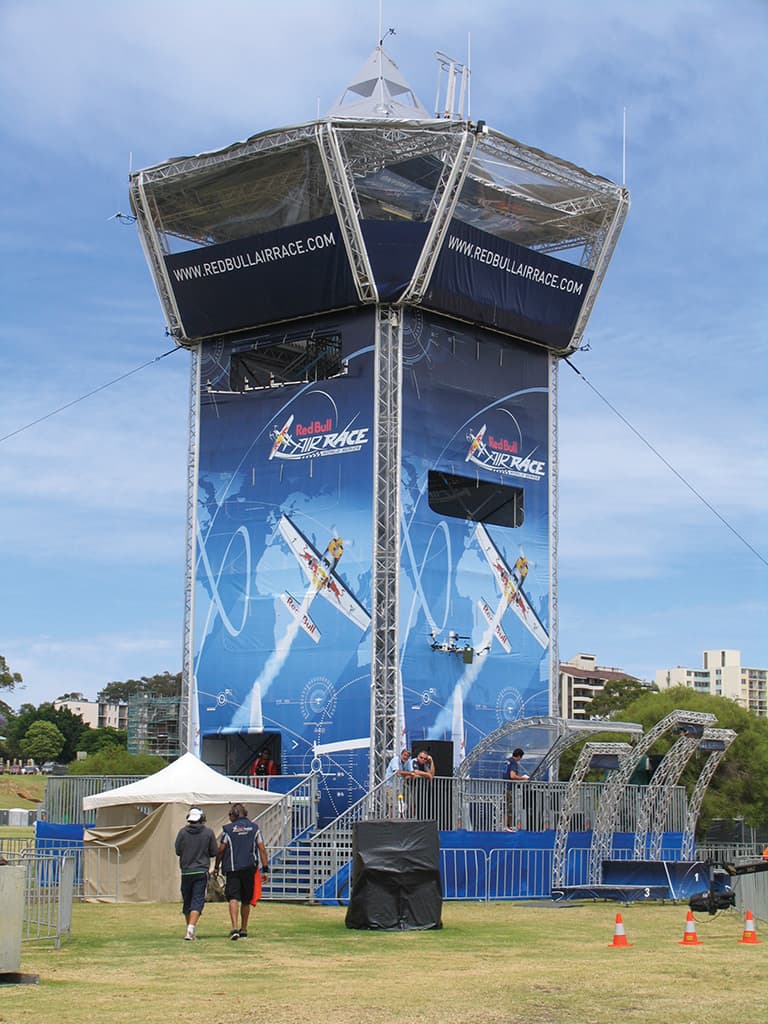
Red Bull Air Race
How the merry heck do you provide sound for an Air Race… whatever one of those is?
Text: Graeme Hague
I’d better admit from the onset, that I’m pathetically ‘Boys Own’ about aeroplanes. You can blame it on a childhood filled with Biggles stories of shooting down dastardly Huns and a steady diet of Spitfire comics. Given a decent flight simulator and a quiet night at home you might find me putting on the helmet, scarf and gloves, turning the air conditioning down to freezing, placing a fan flat-out in my face, grasping my favourite joystick between my knees and hollering “Tally-Ho!” at the PC monitor as I wheel around the skies of England and France. Personally, I’ve shot down the Red Baron about six times and single-handedly won the Battle of Britain at least twice. No mean feat. Mind you, my wife is getting a bit annoyed about being woken up by all the ‘ballyhoo’. But war is hell.
So you’ll understand that when AT asked me if I wanted to check out the Red Bull Air Race over the Swan River in Perth, there wasn’t a moment’s hesitation. Are you kidding? Magnificent men in their flying machines stunting all over the sky? Helicopters and F18 fighters and… oh, right – a bit of PA gear somewhere.
I arranged to meet AAA’s Neil Campbell on the site at the Red Bull compound on the Saturday, which was a day for time-trials to establish pole positions. The pressure wouldn’t be entirely on and punters not so thick on the ground. The next day, Sunday, was the real race day.
Neil and his team at AAA Productions started swapping emails with the Red Bull Racing management way back in February and from the start it was obvious he was dealing with a very slick and switched-on organisation. A genuine flying circus was coming to town and they wanted the best of everything. It’s not surprising. When the main act is flying at 400kph and around 20 feet above the water nobody’s going to want a culture of compromise or “she’ll be right”.
For those readers wondering what the hell I’m talking about, the Red Bull Air Race is a series of international race meetings held all over the world including, you have to say, some of the most exotic and stunning locations like Istanbul, Berlin, Abu Dhabi, or Budapest. Nine pilots compete in time-trials, flying their planes through a circuit of enormous, inflated gates in a particular way (right wing down for one, left wing down the next, a half-Cuban roll between two, etc). The sight is breath-taking and the courses are specially picked to allow spectators to get close to the action. Which for AAA meant an unusual ‘venue’ to cover.
The river foreshore officially allocated for crowds was just over a 1.5km long and 200m deep – not exactly ‘Festival Hall’. Beyond this were extra displays, food vans and the usual carnival hangers-on to cater for the masses, but these weren’t considered as part of the proper viewing zones. Crowds of up to 300,000 were expected on the Sunday at vantage points all over the river with probably a third of them inside the area promoted as prime viewing space – Neil Campbell’s responsibility. At least the program material was fairly straightforward, being a single feed from the Control Tower with a mix of the commentators’ chatter, some hyped-up music underneath, interruptions from the Race Controller and even the pilot’s replies to his instructions.

For a soundcheck, AAA had a half-hour to make noise at 3.30pm – that was it.
It’s not that the Red Bull folks were being difficult. Rather, they have a strong policy of keeping as many tricks up their sleeve as they can for the big day. They didn’t want anyone to hear the PA on the Friday or Saturday, the huge video screens that were to relay camera shots from the helicopters and inside the cockpits stayed blank and many elements of the airshow weren’t rehearsed at all. AAA was totally in agreement, not just to maintain a sense of anticipation around town, but also with their strict ‘the client knows best’ attitude towards corporate gigs. Neil is firm in his belief that there’s no place for any kind of rock ’n’ roll mentality when it comes to doing business with Big Business. You have to think corporate, too.
We took a walk down the line of PA towers. With so much space to cover, Neil opted to use seven L-Acoustics Kudo installations with nine mid/high elements and six subs for each, which seriously emptied AAA’s warehouse. Novatech in Adelaide helped out, supplying extra units. (Their systems expert Milenko Novakovic gets a gold elephant stamp on his homework for ‘services above and beyond’.) The specifications requested by Red Bull asked for 120m throw with 115dB across the entire area of 45,000sqm. The placement and focus of each tower was designed not to infringe on each other and create a need for a delay system. Instead, just a slight overlap made sure there were no holes in the soundscape. The setup did produce and expose an interesting idiosyncracy – that between the speed of the aircraft, the commentator’s reaction time to what they’re seeing and the 120m the PA sound was expected to travel, then some of the crowd would hear the broadcast about two seconds later than the real action. Try and configure an ASIO driver to fix that latency!
Getting the signal to each Kudo stack was eventually done the old-fashioned way. Trenches were dug on the Monday and balanced cables laid along the length of the foreshore. At first, a wireless system was contemplated, but it became apparent that at the core of the Red Bull Air Race machine was already an amazing amount of RF communication including constant data transfer and the risk of the radio waves getting tangled up somewhere wasn’t worth entertaining. (Apparently there was a networked rack of transmitters and receivers in the control tower that would make NASA envious). Sedco line amplifiers at each Kudo tower made a rock-solid connection and, just in case, an FM backup tuned slightly below the local commercial stations was ready to go. Simple, but effective.
The Race Controller’s droll instructions to the pilots to ‘enter the box and smoke on’ became a favourite for ground crew sneaking a quick fag behind the offices

For areas closer to the Control Tower, the VIP lounge and other official sections smaller sub-systems – still getting the same feed – were scattered everywhere. In all 48 EV X-Array, 16 EV Deltamax, and 20 RCF ART300A were used. It took 3km of cabling and (including the Kudo towers) 11 different power sources. Not a single earth-loop buzz was ever heard.
And just for the record, there were 250 people in the international entourage bringing 120 tonnes of international freight with them straight from San Francisco. Between the communications network, the video screen and broadcast equipment some 20km of cable was run for this four-hour event.
Later, as the planes began their time trials I wandered close to the control tower and heard the only speakers relaying the commentators practicing their act along with everyone else. (The Race Controller’s droll instructions to the pilots to ‘enter the box and smoke on’ became a favourite of ground crew sneaking a quick fag behind the offices.) It was easy to hear how the hype and excitement could captivate the crowd and suddenly how important the Kudo’s role would be. This wasn’t to be some tin-horn PA squawking in the background, but a very integral part of the whole show. It confirmed my first impression; that the Red Bull Air Race is a complete and very polished production that leaves nothing to chance.
I had an opportunity to hear the whole PA in action when an announcement was made after the time-trials. It really is impressive to hear the Kudos sounding large and crystal clear with an almost home stereo-like quality from 150 metres away across open ground. Walking a quick arc, the coverage was very even and turning towards the stacks brought, as expected, a gentle rise in sound pressure levels as you got closer. I think I saw a Mr Whippy van beat a retreat in disgust.
Ultimately the PA requirements for the Red Bull Air Race were simple. Large in scale, but uncomplicated. However, the client didn’t consider it as a by-line to their otherwise extremely complex logistics. They demanded the same high quality in their audio and the Kudo system from AAA Productions provided it with more to spare. The specifications were well and truly met.
By the way, the specs for the lighting rig? Rumour has it that it was four Par-64 cans.
But it’s just a rumour.
















RESPONSES